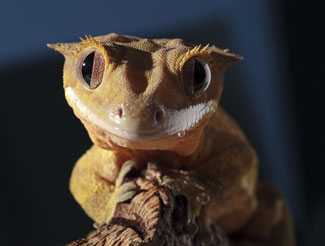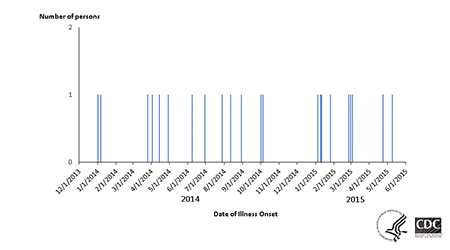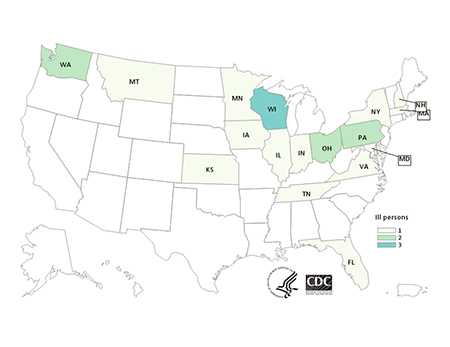Multistate Outbreak of Human Salmonella Muenchen Infections Linked to Contact with Pet Crested Geckos (Final Update)
This investigation is over. However, reptiles continue to be a cause of human Salmonella infections in the United States. More information about Salmonella from reptiles and how you can reduce your risk of infection is available in English and en Español.
Posted June 18, 2015 1:30 PM ET
Highlights
- Read the Advice to Pet Owners »
- This investigation is over; however, illnesses linked to contact with pet crested geckos could continue to be reported at a low level because pet crested gecko owners might be unaware of the risk of Salmonella infection.
- This outbreak was a reminder to follow simple steps to enjoy your pet and keep your family healthy. CDC does not recommend that pet owners get rid of their geckos.
- Reptiles can be carrying Salmonella bacteria but appear healthy and clean and show no signs of illness.
- It is very important to wash your hands thoroughly with soap and water right after touching pet reptiles or anything in the area where they live and roam.
- More steps on how to enjoy your pet reptile and protect yourself and your family from illness are available in English and en Español.
- A total of 22 people infected with the outbreak strain of Salmonella Muenchen were reported from 17 states between January 1, 2014 and June 16, 2015.
- 3 (14%) of these ill people were hospitalized. No deaths were reported.
- Epidemiologic, laboratory, and traceback findings linked this outbreak to contact with pet crested geckos purchased from multiple pet stores in different states.
- 11 (85%) of 13 ill people interviewed reported contact with a crested gecko in the week before their illness began.
- CDC’S National Antimicrobial Resistance Monitoring System (NARMS) laboratory conducted antibiotic resistance testing on Salmonella Muenchen isolates from three ill people infected with the outbreak strain.
- All three isolates were susceptible to all antibiotics tested on the NARMS panel.
Outbreak Summary
Introduction
CDC collaborated with public health, veterinary, and agriculture officials in many states and the U.S. Department of Agriculture National Veterinary Services Laboratories (NVSL) to investigate an outbreak of human Salmonella Muenchen infections linked to contact with pet crested geckos purchased from multiple stores in different states. Crested geckos are popular pet lizards that come in a variety of colors.
Public health investigators used the PulseNet system to identify illnesses that were part of this outbreak. PulseNet is the national subtyping network of public health and food regulatory agency laboratories coordinated by CDC. DNA "fingerprinting" is performed on Salmonella bacteria isolated from ill people by using a technique called pulsed-field gel electrophoresis, or PFGE. PulseNet manages a national database of these DNA fingerprints to identify possible outbreaks.
A total of 22 people infected with the outbreak strain of Salmonella Muenchen were reported from 17 states between January 1, 2014 and June 16, 2015. The number of ill people identified in each state was as follows: Florida (1), Iowa (1), Illinois (1), Indiana (1), Kansas (1), Maryland (1), Massachusetts (1), Minnesota (1), Montana (1), New Hampshire (1), New York (1), Ohio (2), Pennsylvania (2), Tennessee (1), Virginia (1), Washington (2), and Wisconsin (3).
Dates that illnesses began ranged from January 1, 2014 to May 9, 2015. Ill people ranged in age from younger than 1 year to 57 years, with a median age of 14. Fifty-five percent of ill people were female. Three (14%) people were hospitalized. No deaths were reported.
Investigation of the Outbreak
Epidemiologic, laboratory, and traceback investigations conducted by officials in local, state, and federal public health agencies indicated that contact with pet geckos was the likely source of this outbreak.
In interviews, ill people answered questions about contact with animals and foods consumed during the week before becoming ill. Eleven (85%) of 13 people interviewed reported contact with reptiles or their environments before becoming ill. The percentage of ill people in this outbreak reporting contact with a reptile is substantially higher than the percentage of U.S. households that reported owning a pet reptile in a 2013-2014 survey conducted by the American Pet Products Association (4.6%). When asked about the type of reptile, all 11 people reported contact with crested geckos.
The Minnesota Public Health Laboratory isolated the outbreak strain of Salmonella Muenchen from a sample collected from an ill person’s pet crested gecko.
CDC's NARMS laboratory conducted antibiotic resistance testing on Salmonella Muenchen isolates from three ill people infected with the outbreak strain; all three isolates were susceptible to all antibiotics tested on the NARMS panel.
This investigation is over; however, illnesses linked to contact with pet crested geckos could continue to be reported at a low level because pet crested gecko owners might be unaware of the risk of Salmonella infection. This outbreak was a reminder on the need for people to follow simple steps to enjoy their pet and keep family members healthy. CDC does not recommend that pet owners get rid of their geckos. However, if pet owners decide to do so, they should contact a local reputable pet store or reptile rescue for a safe way to relinquish their pet. Do not let a pet gecko loose into the environment.
June 18, 2015
Final Case Count Update
A total of 22 people infected with the outbreak strain of Salmonella Muenchen were reported from 17 states between January 1, 2014 and June 16, 2015. Since the last update on May 14, 2015, two additional ill people were reported from Maryland and Wisconsin. The total number of ill people identified in each state was as follows: Florida (1), Iowa (1), Illinois (1), Indiana (1), Kansas (1), Maryland (1), Massachusetts (1), Minnesota (1), Montana (1), New Hampshire (1), New York (1), Ohio (2), Pennsylvania (2), Tennessee (1), Virginia (1), Washington (2), and Wisconsin (3).
Dates that illnesses began ranged from January 1, 2014 to May 9, 2015. Ill people ranged in age from younger than 1 year to 57 years, with a median age of 14. Fifty-five percent of ill people were female. Three (14%) people were hospitalized. No deaths were reported.
Initial Announcement
May 14, 2015
CDC is collaborating with public health, veterinary, and agriculture officials in many states and the U.S. Department of Agriculture National Veterinary Services Laboratories (NVSL) to investigate an outbreak of Salmonella Muenchen infections linked to contact with pet crested geckos purchased from multiple stores in different states. Crested geckos are popular pet lizards that come in a variety of colors.
Public health investigators are using the PulseNet system to identify illnesses that may be part of this outbreak. PulseNet is the national subtyping network of public health and food regulatory agency laboratories coordinated by CDC. DNA "fingerprinting" is performed on Salmonella bacteria isolated from ill persons by using a technique called pulsed-field gel electrophoresis, or PFGE. PulseNet manages a national database of these DNA fingerprints to identify possible outbreaks.
As of May 13, 2015, a total of 20 persons infected with the outbreak strain of Salmonella Muenchen have been reported from 16 states since January 1, 2014. The number of ill persons identified in each state is as follows: Florida (1), Iowa (1), Illinois (1), Indiana (1), Kansas (1), Massachusetts (1), Minnesota (1), Montana (1), New Hampshire (1), New York (1), Ohio (2), Pennsylvania (2), Tennessee (1), Virginia (1), Washington (2), and Wisconsin (2).
Dates that illnesses began range from January 1, 2014 to March 7, 2015. Ill persons range in age from younger than 1 year to 57 years, with a median age of 14 years. Fifty-eight percent of ill persons are female. Three (15%) persons have been hospitalized. No deaths have been reported.
This outbreak can be illustrated with a chart showing the number of persons who became ill each day. This chart is called an epidemic curve (epi curve). Illnesses that occurred after April 21, 2015 might not be reported because that can take 2 to 4 weeks after someone becomes ill. Please see the Timeline for Reporting Cases of Salmonella Infection for more details.
Investigation of the Outbreak
Epidemiologic, laboratory, and traceback investigations conducted by officials in local, state, and federal public health agencies indicate that contact with pet geckos is the likely source of this outbreak of human Salmonella Muenchen infections.
In interviews, ill persons answered questions about contact with animals and foods consumed during the week before becoming ill. Ten (91%) of 11 persons interviewed reported contact with reptiles or their environments before becoming ill. When asked about the type of reptile, all 10 (100%) persons reported contact with crested geckos. The percentage of ill persons in this outbreak reporting contact with a reptile is substantially higher than the percentage of U.S. households that reported owning a pet reptile in a survey conducted in 2013-2014 by the American Pet Products Association (4.6%).
CDC's National Antimicrobial Resistance Monitoring System (NARMS) laboratory conducted antibiotic resistance testing on Salmonella Muenchen isolates collected from two ill persons infected with the outbreak strain; both isolates were susceptible to all antibiotics tested on the NARMS panel. CDC's NARMS laboratory continues to conduct antibiotic resistance testing on additional clinical isolates collected from ill persons infected with the outbreak strain. Results will be reported when they become available. NARMS is a U.S. public health surveillance system that tracks antibiotic resistance in foodborne and other enteric bacteria found in people, raw meat and poultry, and food-producing animals. NARMS is an interagency partnership among the CDC, the U.S. Food and Drug Administration (FDA), the U.S. Department of Agriculture (USDA), and state and local health departments. The NARMS human surveillance program at CDC monitors antibiotic resistance in Salmonella and other bacteria isolated from clinical specimens submitted to NARMS by public health laboratories.
The pet industry is working closely with CDC to determine the source of the crested geckos linked to this outbreak in order to prevent additional illnesses. This outbreak is a reminder to follow simple steps to enjoy your pet and keep your family healthy. CDC does not recommend that pet owners get rid of their geckos. However, if pet owners decide to do so, they should contact a local reputable pet store or reptile rescue for a safe way to relinquish their pet. Do not let a pet gecko loose into the environment.
More Information

Crested geckos are popular pet lizards that come in a variety of colors.
- Page last reviewed: June 18, 2015
- Page last updated: June 18, 2015
- Content Source:


 ShareCompartir
ShareCompartir

